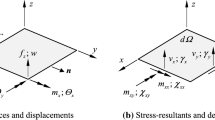Abstract
The dynamic analysis of constant-speed tension crack growth in an elastic half-plane assisted by a rigid wedge traveling also at a constant speed is performed. By modeling the crack as an array of dislocations distributed w.r.t. speed, the analysis reduces to dual integral equations. These equations can, in turn, be replaced by one singular integral equation of the Cauchy type subject to constraint equations. A standard numerical solution approach then yields not only the solution but information on the crack growth in terms of various dimensionless input parameters.
In particular, it is found that the wedge speed uniquely determines the wedge half-plane/material separation point speed, while the crack speed depends on the wedge angle, half-plane tension and a dynamic stress intensity factor parameter. Moreover, these input quantities cannot be specified independently.
Similar content being viewed by others
References
L.M. Brock, “Two basic wave propagation problems for the non-uniform motion of displacement discontinuities in a half-plane,” International Journal of Engineering Science17, 1211–1223 (1979)
L.M. Brock, “The non-uniform motion of a thin smooth rigid wedge into an elastic half-plane,” Quarterly of applied Mathematics,38, 209–223 (1980)
I. Stakgold,Green's Functions and Boundary Value Problems, Wiley, New York (1979)
L.M. Brock, “Dynamic analysis of non-symmetric problems for frictionless indentation and plane crack extension,” Journal of Elasticity8, 273–283 (1978)
J. Miklowitz, “Wavefront analysis in the non-separable elastodynamic quarter-plane problems, I Part 1: the general method,” Journal of Applied Mechanics104, 797–807 (1982)
P. Burgers and L.B. Freund, “An addendum to the paper: dynamic growth of an edge crack in a half-space,” International Journal of Solids and Structures17, 721–727 (1981)
L.M. Brock and Y.C. Deng, “Dynamic studies of running half-plane and cruciform cracks,” International Journal of Engineering Science 21, 1025–1034 (1985)
G.F. Carrier, M. Krook and C.E. Pearson,Functions of a Complex Variable, McGraw-Hill, New York (1966)
A. Ralton,A First Course in Numerical Analysis, McGraw-Hill, New York (1965)
I.S. Gradshteyn, and I.M. Ryzhik,Table of Integrals, Series and Products, Academic, New York (1980).
F. Erdogan, and G.D. Gupta, “On the numerical solution of singular integral equations,” Quarterly of Applied Mathematics30, 525–534 (1972)
A.R. Robinson, and J.C. Thompson, “Transient stresses in an elastic half space resulting from the frictionless indentation of a rigid wedge-shaped die,” Zeitschrift für angewandte Mathematik und Mechanik54, 139–144 (1974)
Y.C. Deng, “Crack propagation due to the motion of a thin smooth rigid wedge in an elastic half-plane,” Master's Thesis in Engineering Mechanics, University of Kentucky (August 1981)
Author information
Authors and Affiliations
Rights and permissions
About this article
Cite this article
Deng, Y.C., Brock, L.M. & Thompson, J.C. Dynamic analysis of wedge-assisted surface crack growth in tension. J Elasticity 16, 149–161 (1986). https://doi.org/10.1007/BF00043582
Received:
Issue Date:
DOI: https://doi.org/10.1007/BF00043582




